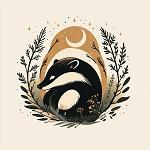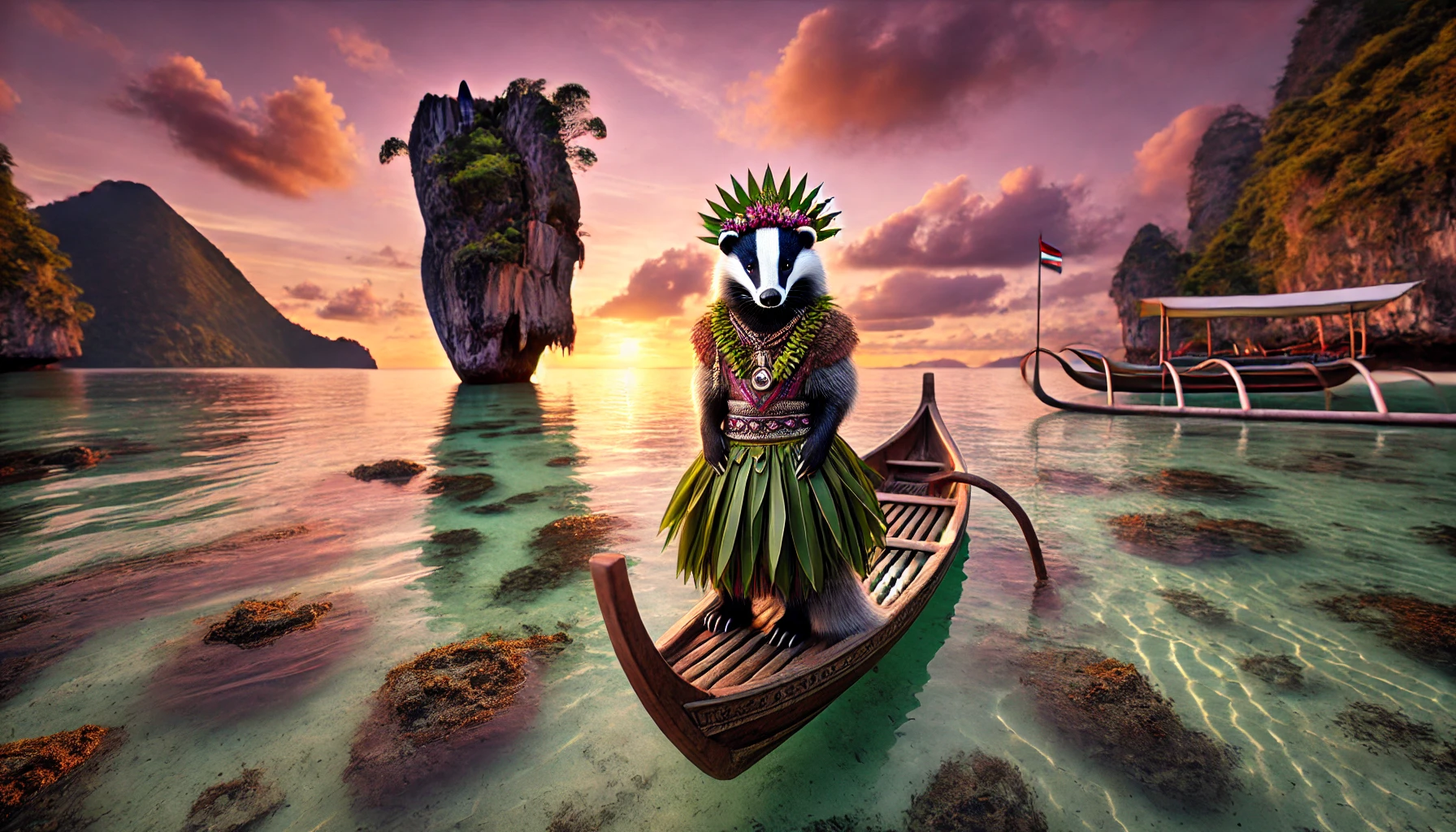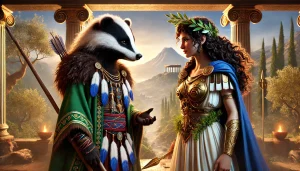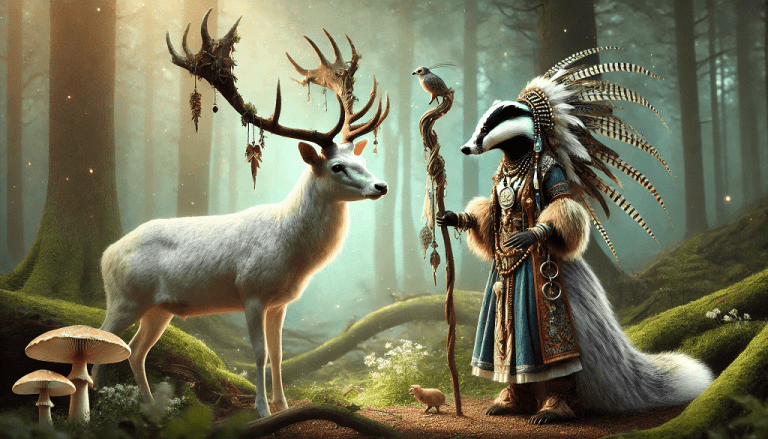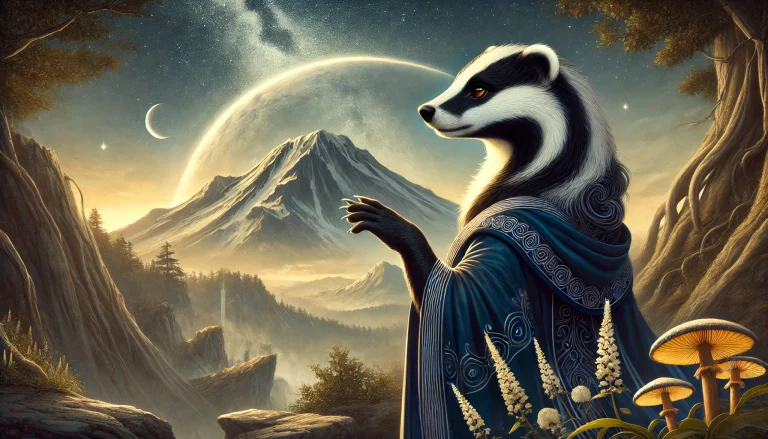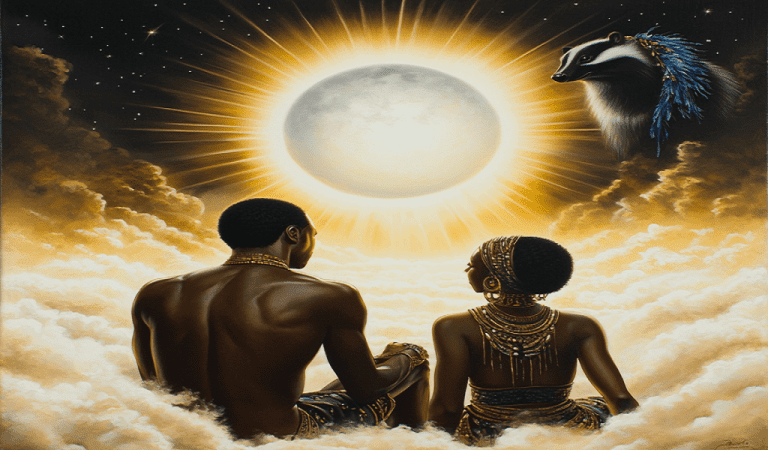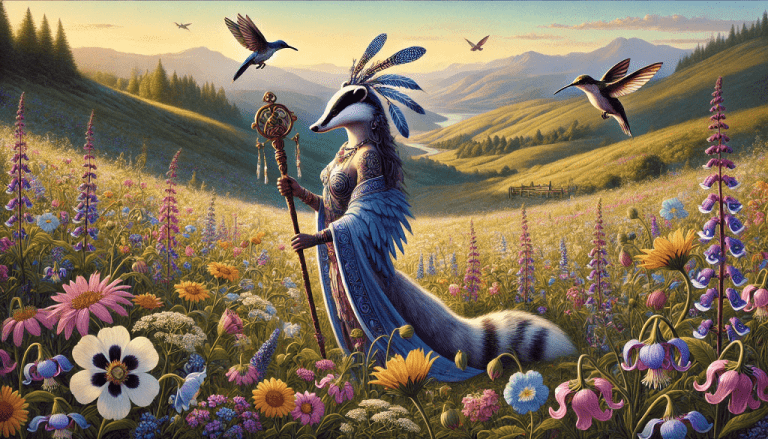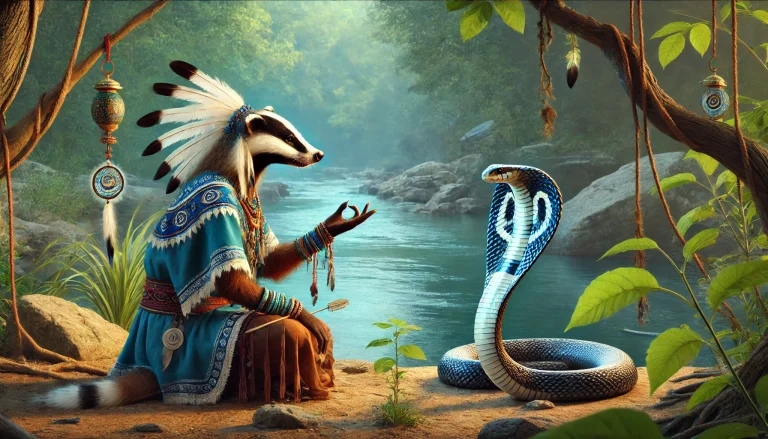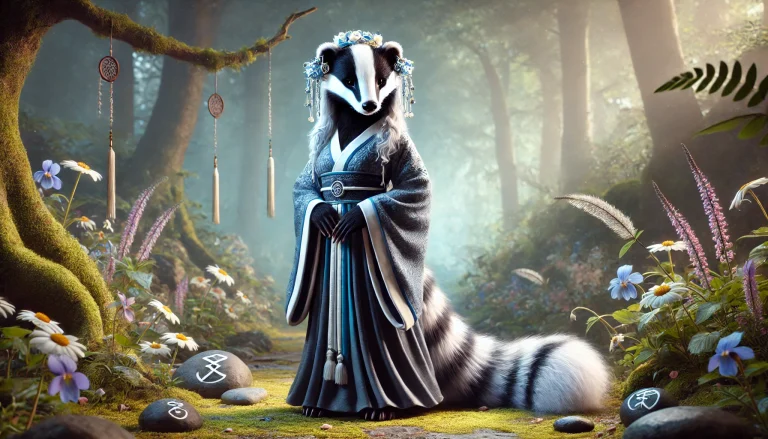Polynesian mythology holds a vast repertoire of stories that reveal the deep connection between the peoples of the Pacific islands and the elements of nature: the ocean, the earth and the sky. With powerful gods, legendary heroes and ancestral spirits, these oral traditions keep alive the teachings about the creation of the world, natural forces and cultural values. Although each island has its own versions of these legends, together they form a rich mythological tapestry, reflecting the wisdom and respect for nature that have shaped Polynesian life and culture for generations.
Index
Geographical and Cultural Context
Polynesia is a vast region of the Pacific Ocean, made up of more than a thousand islands scattered over an area that covers around 16 million square kilometers. This territory includes countries and territories such as Hawaii, New Zealand, Tahiti, Samoa, Tonga and the Marquesas Islands, among others. Geographically, Polynesia is marked by its isolation and the dispersion of its islands, forming a triangle that stretches from Hawaii in the north to New Zealand in the southwest and Easter Island in the southeast.
Culturally, the Polynesian peoples share a rich heritage, characterized by oral traditions, navigation and a deep mythology that permeates every aspect of daily life. Traditional Polynesian society has a strong connection with the ocean and nature, something that is reflected in both their legends and religious practices. The art of navigation, without the use of modern instruments, is one of the greatest achievements of these peoples, who colonized vast areas of the Pacific guiding themselves only by the stars, ocean currents and signs of nature.
In Polynesian mythology, the gods and spirits are deeply connected to the environment, associated with elements such as the sea, volcanoes and forests. These myths not only narrate the creation of the world and humanity, but also act as moral guides and codes of conduct for the communities. The preservation of these stories through oral tradition has been essential for the continuity of Polynesian culture over the centuries.
The Importance of Mythology
Polynesian mythology plays a central role in the life and identity of the people who inhabit this vast region of the Pacific Ocean. More than just stories, Polynesian legends and myths are an essential link that connects people to their history, culture and environment. Through these narratives, Polynesians have preserved their knowledge, values and traditions over the generations, overcoming geographical isolation and the transformations brought about by contact with other cultures.
These mythologies not only explain the origin of the world and humanity, but also provide a deeper understanding of the role that each element of nature plays in everyday life. Gods, spirits and heroes present in Polynesian legends are often linked to natural forces such as the sea, wind, mountains and volcanoes, reflecting the dependence and respect that Polynesian cultures have for the nature around them.
In addition, mythology acts as a moral compass, advising on the importance of living in harmony with others and the environment. Stories of gods and spirits who punish those who disrespect the land or traditions teach valuable lessons about balance and sustainability. In a region where life depends heavily on natural resources, these narratives are fundamental to the survival and well-being of communities.
Mythology also plays a crucial role in social cohesion, strengthening unity and cultural identity among the dispersed peoples of Polynesia. Shared legends create a sense of belonging and continuity, connecting individuals not only to their own group, but to a vast network of related cultures. This shared identity is essential for preserving traditions and resisting external influences.
Main Themes of Polynesian Mythology
Connecting with Nature
Polynesian mythology is deeply rooted in the intimate relationship that the Polynesian peoples have with the environment. Surrounded by the vast Pacific Ocean, these peoples have developed a deep respect and understanding of the natural elements that sustain their lives. The sea, the islands, the sun, the winds and even the volcanoes occupy central roles in their legends, reflecting the importance of these elements in everyday life.
The Ocean
The ocean is undoubtedly the most vital element in Polynesian mythology. As well as being a source of food and sustenance, it is the path that connects the islands and their scattered inhabitants. In mythology, the sea is often personified by powerful gods and spirits, such as Tangaroa, the god of the sea, revered as one of the creator deities of the world. Stories involving the ocean often emphasize the relationship between humans and the sea, highlighting the importance of respect and harmony to ensure safety and prosperity.
The Islands
The islands of Polynesia are seen as gifts from the gods, sacred sanctuaries that offer shelter and resources to those who inhabit them. Many legends describe the creation of these islands by heroes or gods, such as Maui, famous for having pulled islands from the bottom of the ocean with his magic hook. In some mythologies, islands are personified, representing Mother Earth, who nurtures and sustains life.
The Sun and the Sky
The sun and celestial elements also play a crucial role in Polynesian mythology. The sun, for example, is revered for its light and warmth, which are essential for life. One of the best-known legends involves Maui, who managed to slow down the sun's movement to ensure that the days were long enough for people to work and enjoy life. The sky, meanwhile, is the domain of the higher gods, who observe and govern the mortal world.
Volcanoes and mountains
Volcanoes and mountains are often seen as dwellings of the gods or as physical manifestations of deities. In Hawaiian mythology, Pele, the goddess of volcanoes, is a central figure, known as much for her ability to create new lands as for her destructive power. These natural formations are revered and feared, symbolizing both creation and destruction.
Conclusion
The connection with nature, in Polynesian mythology, goes beyond reverence; it is a practical and spiritual necessity. Polynesians believe that living in harmony with the environment is essential for survival, and that imbalances can result in natural disasters or other calamities. The legends and stories that arise from this deep relationship with nature are fundamental to understanding the worldview of the Polynesian peoples.
Heroes and Tricksters
In Polynesian mythology, heroes and tricksters play central roles, shaping the world and influencing people's lives through their adventures and cunning. One of the most iconic archetypes of this mythology is Maui, the demigod known as much for his intelligence as for his extraordinary feats. These characters are not mere entertainers; they symbolize the complexities of life, revealing that good and evil, wisdom and foolishness, are often intertwined in their stories and actions.
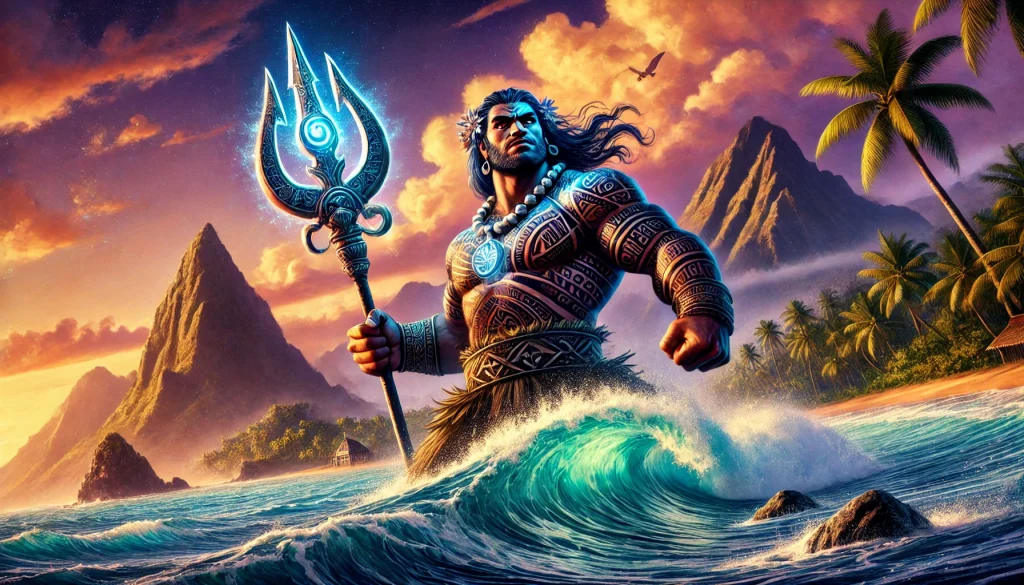
Maui - The Ultimate Hero and Trickster
Maui is one of the best-known and most revered figures in Polynesian mythology, often described as a trickster hero. Using his intelligence and cunning, Maui performs extraordinary feats that often benefit humanity, but also challenge the established order. Among his most celebrated feats are the creation of the islands by "fishing" pieces of land out of the ocean, slowing down the sun to lengthen the day and bringing fire to human beings.
These stories reflect Maui's duality: he is both a benefactor and a troublemaker. His ability to defy the gods and change reality reveals the idea that the world is changeable, and that cunning and courage can be transformative forces. However, his actions also bring consequences, reminding us that power must be exercised responsibly.
Other Heroes and Tricksters
In addition to Maui, several other heroic and trickster figures appear in Polynesian mythology, each with their own stories and lessons. These characters often move between the divine and the human, demonstrating that even the most powerful can be fallible. They play with the rules of nature and society, challenging the status quo and thereby bringing new possibilities and transformations.
These heroes and tricksters are not always morally perfect. They represent the complexity of life, where good intentions can generate unexpected results, and where cunning can be both a blessing and a curse. Their stories teach that courage and intelligence are essential for overcoming challenges, but that these qualities must always be balanced with wisdom and care.
Impact on Mythology and Culture
The heroes and tricksters of Polynesian mythology play an essential role in passing on cultural values and life lessons. The stories of Maui and other similar characters are passed down from generation to generation, exemplifying what it means to be brave, intelligent and adaptable. These narratives show that life is full of challenges, but that with cunning and determination it is possible to overcome obstacles and, on some occasions, even outwit the gods.
These characters are fundamental to understanding Polynesian mythology, as they embody the belief that life is a delicate balance between opposing forces, where adaptability is essential for survival and success.
Life Cycle and Death
In Polynesian mythology, the cycle of life and death is seen as a natural and essential part of existence, with life being a continuous journey that extends beyond physical death. Polynesians believe that death is not the end, but a transition to a new form of existence, where the spirits of the deceased continue to influence the world of the living. This cyclical view of life is a pillar of Polynesian spirituality, with ancestors playing a crucial role in maintaining balance and passing on wisdom to future generations.
Death as Transition
In Polynesian mythology, death is seen as a passage into a new phase of existence. Unlike many Western cultures, which see death as a definitive end, Polynesians believe that the dead continue to live in a spiritual realm, from where they can interact with the world of the living. This realm is often described as a place of rest and renewal, but also as a place of great power, where spirits can exert influence over events on Earth.
The Spirits of the Ancestors
The ancestors, or atua, in many Polynesian cultures, are deeply revered and respected, and are seen as guardians and guides for the living. They are invoked in times of need, and their guidance and protection is sought through rituals and ceremonies. These spirits not only maintain a connection with their families, but also with the land, the sea and other elements of the natural environment. It is believed that, through the ancestors, the wisdom of the past is preserved and passed on, ensuring the continuity of traditions and the prosperity of the community.
The Role of Gods and Spirits
The gods in Polynesian mythology also play an important role in the cycle of life and death, often acting as mediators between the world of the living and the dead. Some deities are charged with guiding spirits to the other world, while others are invoked to protect the living from evil influences. The belief in spirits capable of helping or harming the living is a crucial part of mythology, reinforcing the idea that the spiritual world is in constant interaction with the physical world.
Rituals and celebrations
Rituals associated with death and ancestral spirits are fundamental to maintaining harmony between the worlds of the living and the dead. These rituals vary according to the culture, but often include offerings, songs and dances that honor the spirits and ask for their blessings. In many Polynesian cultures, ancestral graves are sacred places where families gather to connect with the spirits and renew their ties with the earth.
The Continuity of Existence
The continuity of existence, in the Polynesian view, is guaranteed by the interdependence between the living and the dead. By honoring the ancestors and following their guidance, Polynesians believe they can ensure the prosperity and protection of their community. This symbiotic relationship is seen as essential for survival and for maintaining the natural and spiritual balance.
Conclusion
The cycle of life and death in Polynesian mythology is a continuous and interconnected process, where death is simply a transition to another form of existence. The spirits of the ancestors play a central role in this cycle, ensuring the transmission of wisdom and the protection of future generations. Through rituals and reverence for the ancestors, Polynesians keep the connection with their past alive, ensuring that life continues in harmony with the world around them.
Structure and Pantheon of the Gods
Polynesian mythology is rich in a vast pantheon of gods, each governing specific aspects of nature and human life. These gods are deeply revered, and their stories are passed down from generation to generation, forming the basis of Polynesian spirituality. Among the most important deities are primordial figures such as Rangi (god of the sky) and Papa (goddess of the earth), as well as gods who control the sea, forests, agriculture and even volcanoes.
Rangi (Ranginui) - God of Heaven
Rangi, also known as Ranginui, is the god of the sky and one of the central figures in Polynesian mythology. He is considered the father of many other gods and is eternally united with Papa, the goddess of the Earth. Together, they symbolize the union between heaven and earth. The separation of Rangi and Papa, carried out by their children to allow light into the world, is one of the founding myths of Polynesian cosmology. Even when separated, Rangi continues to observe his descendants from above, representing the spiritual link between the earthly and heavenly worlds.
Pope - Earth Goddess
Papa is the goddess of the earth and consort of Rangi. She is the source of all life, personifying the fertility and abundance of nature. The union of Rangi and Papa generated many of the Polynesian gods, and their separation allowed the development of the world. Revered as the mother of all living beings, Papa is present throughout nature, from the mountains to the fertile plains, nurturing and sustaining life.
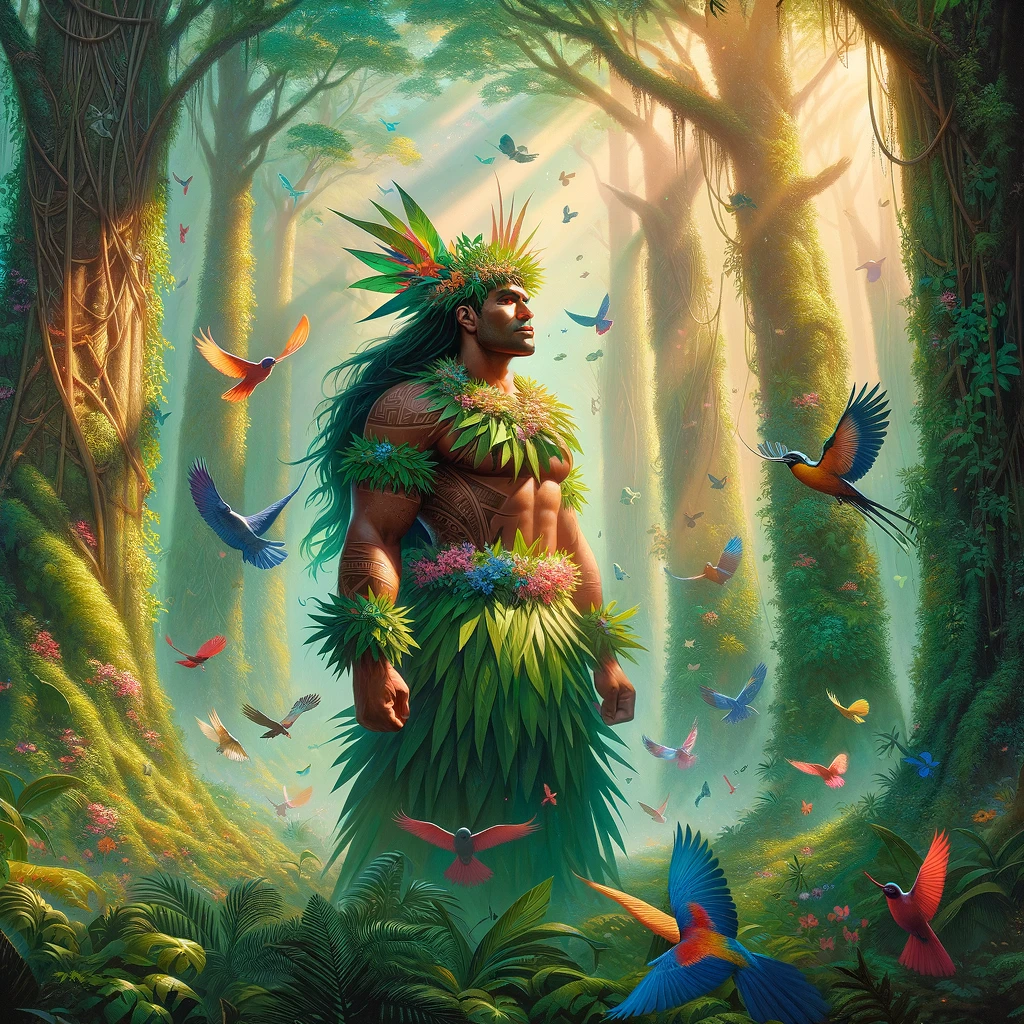
Tangaroa - God of the Sea
Tangaroa is one of the most powerful and ancient deities in Polynesian mythology and is worshipped as the god of the sea. Creator of the oceans and all sea creatures, he is essential to the survival of Polynesian communities, who depend on the sea for food and transportation. Tangaroa is an imposing figure, capable of controlling the tides and winds, and is worshipped in rituals that seek to guarantee safety and success in sea voyages, reflecting the vital importance of the ocean in Polynesian life.
Comparison with Poseidon
Like Tangaroa, Poseidon is the god of the seas in Greek mythology. Both are gods of great power and influence, capable of controlling the waters and determining the fate of sailors. While Tangaroa is central to Polynesian cosmology, focused on the creation and preservation of marine life, Poseidon, as well as being the lord of the seas, is also associated with earthquakes and horses. The comparison between Tangaroa and Poseidon highlights how different cultures personify and revere natural forces, each adapting their mythologies to their own needs and environments.
Tane - God of the Forest and Birds
Tane is the god of forests, trees and birds in Polynesian mythology. He is responsible for all plant life on Earth and plays a central role in the creation of the world, being the god who separated Rangi and Papa (heaven and earth), allowing light to enter the world. Tane is also the creator of the first man, symbolizing the balance and harmony between human beings and nature.
Comparison with Artemis
Like Tane, Artemis is a deity linked to nature in Greek mythology, being the goddess of the hunt, wild nature and protector of forests and animals. While Tane is more focused on the creation and preservation of forests and birds, Artemis is associated with hunting and the protection of young animals. Both reflect the importance of nature and the need to respect it, although their roles reflect different aspects of Polynesian and Greek cultures.
Rongo - God of Agriculture and Peace
Rongo is the god of agriculture, fertility and peace in Polynesian mythology. He is essential for ensuring good harvests and is central to the agricultural life of Polynesian communities. In addition to his association with agricultural prosperity, Rongo is invoked to resolve conflicts and maintain peace within communities.
Comparison with Demeter
Like Rongo, Demeter is the goddess of agriculture and fertility in Greek mythology, responsible for the growth of crops and the cycle of the seasons. Both gods are crucial to agriculture and the prosperity of communities, representing the bounty of the earth. Rongo also embodies aspects of peace and social harmony, while Demeter is deeply connected to the cycle of life and death, through the myth of her daughter Persephone.
Pele - Goddess of Volcanoes
Pele is the goddess of volcanoes and fire in Hawaiian mythology, known for her creative and destructive nature. Her volcanic eruptions shape the landscape of the Hawaiian islands and she is revered as a powerful and unpredictable force, capable of renewing the earth through fire.
Comparison with Hephaestus
Like Pele, Hephaestus is the god of fire and volcanic eruptions in Greek mythology. He is the master of forges and metallurgy, controlling fire as a creative and destructive force. Both gods represent the transformative power of fire. While Pele is directly linked to volcanoes and the creation of new lands, Hephaestus is associated with the creation of artifacts and the mastery of underground forges.
Hina - Goddess of the Moon and Turtles
Hina is a goddess associated with the moon, fertility and sea turtles in Polynesian mythology. She is revered for her connection to the moon and her influence on the tides and the cycle of life. Hina symbolizes rebirth and renewal and is a central figure in many Polynesian legends.
Comparison with Selene
Like Hina, Selene is the goddess of the moon in Greek mythology, personifying the moon and often portrayed as a beautiful and mysterious figure crossing the night sky. Both are symbols of the moon, influencing the natural and spiritual cycles in their cultures. Hina has a more practical role, linked to fertility and controlling the tides, while Selene is associated with the celestial and poetic aspect of the moon.
Kanaloa - God of the Underworld and the Oceans
Kanaloa is an important deity in Hawaiian mythology, often associated with both the ocean and the underworld. He represents the depths of the sea and the mysteries that reside there, and is seen as a figure who balances the vast power of the ocean with a darker, more enigmatic aspect. Kanaloa is revered in rituals linked to sailing and the sea, symbolizing both life and death, as well as the transition between these two states.
Comparison with Hades
Like Kanaloa, Hades is the god of the underworld in Greek mythology, ruling the realm of the dead. While Hades is mainly associated with death and the underworld, Kanaloa has a dual connection with the ocean and the underworld, reflecting the interconnection between these realms in Polynesian cosmology. Both gods symbolize the mystery surrounding the world of the dead and the importance of rituals to navigate between life and death. However, while Hades is restricted to the underworld, Kanaloa also rules the domain of the ocean, representing the hidden and powerful forces of nature.
Conclusion
Comparisons between Polynesian deities and their counterparts from other mythologies reveal how peoples from distinct and often isolated cultures have developed similar concepts about gods and their functions in the universe. This suggests that, despite geographical and cultural differences, there is a universal human tendency to personify natural and spiritual forces in ways that reflect humanity's common needs and experiences.
This idea is in line with the theory of the collective unconscious proposed by Carl Jung, who suggests that all human beings share a collective memory made up of universal archetypes - patterns of thought and behavior that emerge in the mythologies, legends and religions of all cultures. The gods and heroes of these mythologies can be seen as manifestations of these archetypes, which, according to Jung, reside in humanity's collective unconscious.
The presence of gods with similar characteristics and functions in such different cultures can thus be interpreted as an expression of these universal archetypes. These similarities not only enrich our understanding of individual mythologies, but also offer a deeper insight into the shared connections that unite all cultures over time, reflecting a collective memory that transcends the barriers of time and space.
Relations between the gods
Polynesian mythology is rich in stories of complex and dynamic relationships between the gods, reflecting the duality and conflicts present in both the spiritual and natural worlds. These interactions often shape the structure of the universe and directly influence the lives of humans. Family relationships, rivalries and alliances between deities are central to mythical narratives, demonstrating how balance and chaos are constantly negotiated between divine forces.
Rangi and Papa - Union and Primordial Separation
Rangi, the god of the sky, and Papa, the goddess of the earth, are the progenitors of many other gods in Polynesian mythology. Initially, Rangi and Papa were so closely united that there was no room for light or life to thrive between them. Their children, suffocated in darkness, decided to separate them to allow the creation of the world. Tane, the god of the forests, was responsible for finally separating his parents, raising Rangi to the sky and leaving Papa as the earth. This act of separation is one of the founding myths of Polynesian mythology, explaining the origin of the world and the creation of order.
Even though they are separated, Rangi and Papa continue to mourn their split, and their tears manifest as rain and dew, symbolizing the eternal love between heaven and earth, even at a distance. This story not only explains the creation of the universe, but also illustrates how creation often involves sacrifice and pain, a recurring theme in interactions between gods and humans.
Tane and Tangaroa - Rivalry between Land and Sea
Tane, the god of the forests, and Tangaroa, the god of the sea, are brothers, both sons of Rangi and Papa, but their relationship is marked by a deep rivalry. While Tane represents the earth and its natural riches, Tangaroa dominates the sea and all the creatures that inhabit it. This rivalry reflects the duality between land and sea, two elements that are fundamental to Polynesian life, but which can also be in constant conflict.
In some traditions, this rivalry manifests itself in direct conflicts, where Tane and Tangaroa compete for control of resources and the loyalty of other gods and humans. The tension between land and sea serves as a metaphor for the challenges faced by Polynesians in balancing their needs between land and sea resources.
Maui - The Trickster and Challenger of the Gods
Maui, the trickster demigod, is famous for challenging the authority of the gods, including his own relatives. In his many adventures, Maui often deceives the gods and tries to change the world for the benefit of mankind, such as when he slowed down the sun to lengthen the day or tried to grant humans immortality by confronting the goddess of death.
Maui is both a hero and a subversive figure who challenges the order established by the major gods. His relationship with the deities is ambivalent: he is respected for his exploits, but also feared for his ability to create chaos and alter the natural balance. Maui personifies the power of cunning and determination, even in the face of divine forces.

Skin and Your Family Conflicts
Pele, the goddess of volcanoes, is an imposing figure in Hawaiian mythology, known for her intense conflicts with her brothers and sisters, especially her sister Hina. Pele is often portrayed as a goddess with an explosive temper, whose passions result in destructive volcanic eruptions. Her relationship with her brothers, who rule over other natural elements such as the sea and storms, is marked by rivalries that symbolize the uncontrollable forces of nature.
The rivalry between Pele, associated with fire, and Hina, linked to the moon and water, represents the eternal conflict between fire and water, creation and destruction. These family conflicts reflect the cyclical and balanced nature of the world, where opposing forces coexist in a continuous dance of construction and demolition.
Rongo and Tūmatauenga - Peace and War
Rongo, the god of agriculture and peace, and Tūmatauenga, the god of war, represent opposing but complementary forces in Polynesian mythology. While Rongo is associated with the fertility of the land and social harmony, Tūmatauenga is invoked in times of conflict and is the patron of warriors. The relationship between these two gods reflects the necessary balance between peace and war, agriculture and defense, showing that both forces are essential for the survival and prosperity of Polynesian communities.
The coexistence of Rongo and Tūmatauenga highlights the duality of life: cultivation and protection, creation and destruction. Polynesian communities revere both gods, recognizing that without Rongo's peace and fertility, there is no growth, and without Tūmatauenga's strength, there is no security.
Conclusion
The relationships between the gods in Polynesian mythology are complex and reflect the tensions and balances that govern the natural world. The rivalries, alliances and conflicts between these deities not only explain natural phenomena, but also convey lessons about interdependence and the need for balance in all aspects of life. These stories reveal the deep layers of meaning in Polynesian traditions, offering a richer understanding of the interconnection between the gods, humans and the world around them.
Modern Cultural References
Polynesian mythology, with its rich stories and vibrant characters, continues to significantly influence modern culture, both in the Pacific islands and on a global scale. In Polynesian communities, ancestral traditions and myths live on through festivals, ceremonies and cultural practices that honor the gods and spirits of the ancestors. These events not only preserve cultural heritage, but also reinforce collective identity and the connection with the lands and seas that are central to Polynesian life.
An example of this is Heiva i Tahiti, a traditional festival in Tahiti, where dances, music and rituals are presented to the public, incorporating elements of local mythology. These cultural events are an opportunity for new generations to learn about their roots and keep alive the stories that shaped the lives of their ancestors.
Globally, Polynesian mythology has gained prominence through representations in the media, especially in films and books. One of the most notable examples is the Disney film Moana, which features characters inspired by Polynesian mythology, such as the demigod Maui. Moana brought to life many of the legends and traditions of the Pacific islands, presenting them to a global audience and celebrating Polynesian culture in an accessible and captivating way.
The character of Maui, with his charismatic personality and divine powers, is a modern reinterpretation of one of the most iconic figures in Polynesian mythology. The success of Moana not only popularized Polynesian stories, but also underlined the importance of respecting and authentically representing indigenous cultures in wide-ranging productions.
In addition, Polynesian mythology influences other art forms, such as literature, music and the visual arts. Contemporary Pacific Island authors often incorporate mythological themes and characters into their works, exploring the relevance of these stories in the modern context. Similarly, visual artists and musicians use the iconography and symbols of Polynesian mythology to express their cultural identity and address contemporary issues.
These modern cultural references demonstrate how Polynesian mythology continues to be a vital source of inspiration, both for those who live in the Pacific islands and for a global audience that is enchanted by the depth of these stories. By keeping these traditions alive and adapting them to new forms of expression, Polynesian culture remains vibrant and relevant in today's world.
Spiritual and Philosophical Application
Polynesian mythology is not just a collection of ancient stories; it offers lessons and values that remain deeply relevant in modern life. Polynesian narratives are full of teachings about respect for nature, the balance between opposing forces and the importance of community - principles that can guide our actions and decisions in the contemporary world.
Respect for Nature
One of the clearest messages in Polynesian mythology is the deep respect for nature. Polynesian gods and spirits are often personifications of natural elements, such as the sea, the forest and volcanoes, and the legends emphasize the need to live in harmony with the environment. In modern life, this vision can inspire us to adopt more sustainable practices and take care of the planet. In times of climate change and environmental degradation, the respect for nature taught in Polynesian stories serves as a powerful reminder of the interdependence between humanity and the natural world.
Balance between Opposing Forces
Many Polynesian stories deal with the concept of balance between opposing forces - light and darkness, life and death, creation and destruction. This duality is exemplified in myths such as that of Rangi and Papa, whose sons separated heaven from earth to allow life to flourish. This idea of balance between opposites resonates with the Chinese philosophy of Yin and Yang, which also represents the interdependence of opposing but complementary forces. Both traditions teach that harmony arises from the balance between these contrasting energies.
In modern life, these philosophies encourage us to seek balance, whether it's between work and leisure or between progress and conservation. They remind us that well-being comes from the ability to navigate between opposites and find harmony, recognizing that both sides of a duality are essential.
Importance of the Community
Polynesian mythology also emphasizes the importance of community and social ties. The gods and heroes often act not only for their own benefit, but to protect and ensure the prosperity of the community. This focus reflects the Polynesian social structure, where cooperation and mutual support are fundamental to survival and success. In modern life, this emphasis on community encourages us to value collaboration over competition and to work together to solve common challenges. The importance of community is an antidote to excessive individualism, promoting a more supportive view of life.
Ritual and Everyday Spirituality
In addition, Polynesian mythology teaches the importance of rituals and spirituality in everyday life. Rituals to honor the gods, celebrate the seasons or mark life transitions such as birth and death are common in Polynesian cultures. Incorporating moments of spiritual reflection into our modern lives can help us maintain a connection with something bigger, feel more grounded and find meaning in life's small and large transitions.
Conclusion
By applying the lessons and values of Polynesian mythology to our lives, we can develop a greater awareness of our relationship with nature, seek balance and strengthen community ties. Just like the Yin and Yang in Chinese philosophy, Polynesian stories remind us that harmony arises from the balance between opposing forces. These stories offer timeless wisdom that can guide us in building a more harmonious and meaningful life for ourselves and future generations.
What comes next
Polynesian mythology is vast and full of fascinating stories that reflect the cultural and spiritual richness of the Pacific peoples. In this article, we explore the general structure of the Polynesian pantheon and some of the most important relationships between the gods. However, there is much more to be discovered.
Over the next few articles, we'll delve into the stories of each god, hero and spirit that make up this rich mythology. From the daring exploits of Maui, the trickster demigod, to the emotional eruptions of Pele, the goddess of volcanoes, each narrative offers valuable lessons and insights into the Polynesians' intimate connection with the natural and spiritual world.
Get ready to discover how these gods and spirits shape the universe, protect the islands and influence people's daily lives. We'll explore the legends that explain the mysteries of the sea, the land, the sky and the underworld, understanding how these stories continue to resonate at the heart of Polynesian cultures today.
Stay tuned for future articles, where we'll unravel the secrets of Polynesian myths and bring to light the stories that continue to inspire and guide generations.
I'm passionate about magic and spirituality, always looking for new knowledge about rituals, energies and the mystical universe. Here, I share magical practices and spiritual tips for those who want to connect more deeply with themselves and the world around them, all in a light and accessible way.
